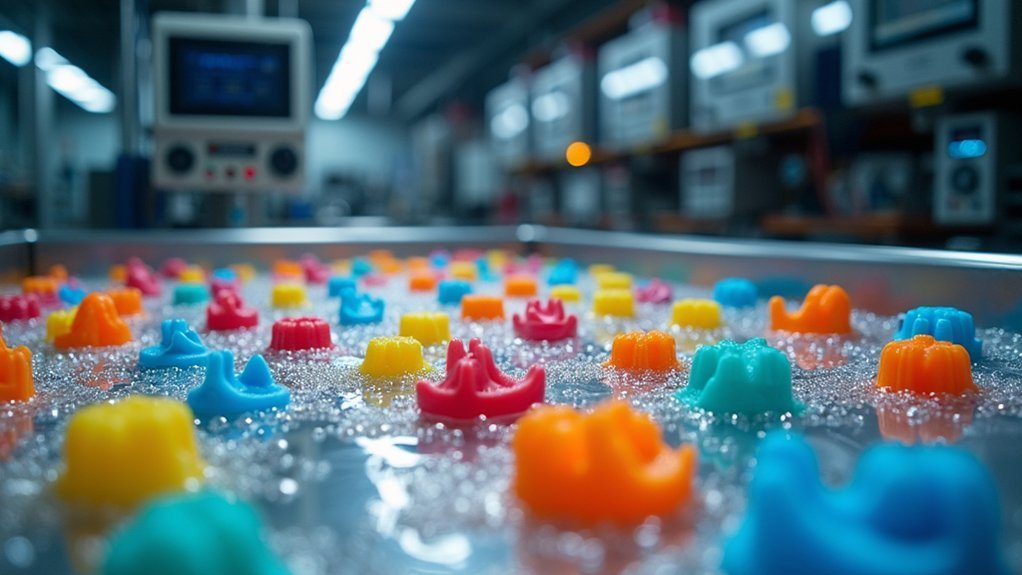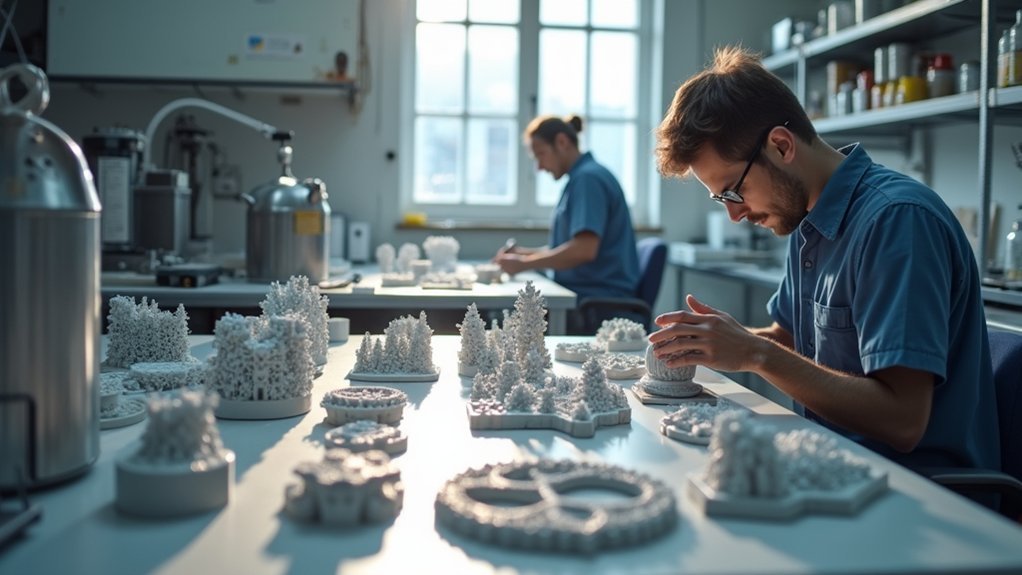You’ll find that industrial 3D print post-processing solutions include automated cleaning systems for resin removal and depowdering, chemical vapor smoothing equipment that delivers injection molding-quality surfaces, and precision CNC machining tools for dimensional accuracy. These systems can reduce labor costs by 30-50% while decreasing processing times up to 90%. From robotic surface finishing that completes cycles in five minutes to integrated support removal systems, these technologies transform raw prints into production-ready components with minimal human intervention, offering substantial ROI potential.
Types of Industrial Post-Processing Equipment and Systems

Industrial post-processing equipment spans several specialized categories, each designed to address specific finishing requirements for 3D printed parts.
You’ll find cleaning systems like the AM Solutions C1 for resin removal and powder depowdering solutions such as Joke Technology’s ENESKApostprocess. Support removal equipment efficiently eliminates unwanted material while preserving part integrity.
Automated solutions greatly enhance your workflow efficiency. The 3DFinisher from 3D Nextech improves mechanical properties and delivers aesthetic enhancement for ABS and ASA parts, achieving injection molding-quality results.
Chemical vapor smoothing technology, featured in the PostPro SF100, increases production efficiency while maintaining fine details.
Surface treatment innovations include the DLyte Pro 500’s patented DryLyte® technology for metal surface finishing.
For color variety, the DyeMansion DM60’s DeepDye Coloring technology offers extensive customization options in complete print-to-product workflows.
Automated Surface Finishing Technologies for Mass Production
Mass production demands require surface finishing technologies that can process hundreds or thousands of parts with minimal human intervention.
Automated surface finishing systems address the critical challenge where 55% of manufacturers find post-processing too time-consuming for industrial applications.
Over half of manufacturers struggle with post-processing bottlenecks that slow industrial 3D printing adoption and productivity.
These advanced technologies transform your 3D print workflow through:
- Chemical vapor smoothing – PostPro SF100 delivers injection molding-quality surfaces for high-volume production while reducing cost per part
- Integrated processing – PostProcess DECI Duo combines support structure removal with surface finishing using TAF technology
- Metal finishing automation – DLyte Pro 500’s DryLyte® technology provides fully automated solutions with minimal maintenance
- Enhanced part quality – 3DFinisher achieves superior surface finishes while enhancing mechanical properties of ABS, ASA, and cellulose acetate components
Chemical Processing Solutions for Enhanced Material Properties

While mechanical finishing methods excel at removing support material, chemical processing solutions target the molecular level to fundamentally enhance your parts’ material properties.
Chemical vapor smoothing utilizes solvent vapors to reduce surface roughness on 3D printed parts, improving aesthetic appeal and moisture resistance without altering underlying structures. Technologies like PostPro SF100 enable large-volume production with considerably reduced per-part costs while enhancing mechanical properties through post-processing.
Infiltration techniques fill printed part gaps with materials like epoxy, minimizing porosity and boosting strength.
Chemical dipping methods effectively melt outer layers on complex geometries, creating smoother finishes and refined details. However, material compatibility determines effectiveness—acetone won’t work on pure PLA, requiring alternative approaches for desired enhancements in different printing materials.
Precision Machining and Subtractive Manufacturing Tools
Beyond chemical approaches, precision machining and subtractive manufacturing tools offer mechanical solutions that directly address dimensional accuracy and surface finish requirements.
These CNC machining processes remove excess material from your 3D printed parts, ensuring you achieve tight tolerances essential for industrial applications.
You’ll benefit from several subtractive methods that enhance both functionality and aesthetic appeal:
- Milling machines and lathes – Remove material precisely while maintaining dimensional accuracy across complex geometries
- Sanding and polishing – Improve surface texture by eliminating visible layer lines and enhancing overall appearance
- Chemical abrasive dipping – Dissolves outer layers through solvent immersion, perfect for intricate parts difficult to reach manually
- Abrasive blasting – Eliminates surface defects consistently across multiple parts, ideal for batch production requirements
These precision machining techniques transform your printed components into production-ready parts.
Advanced Coating and Plating Systems for Industrial Applications

When surface enhancement requirements extend beyond mechanical improvements, advanced coating and plating systems deliver the protective and functional properties your industrial 3D printed parts demand.
Electroplating transforms non-metallic substrates by adding metallic finishes that boost strength and conductivity, expanding opportunities in automotive and aerospace industrial applications.
Spray coating methods provide scalable solutions for achieving specific surface properties like corrosion protection, wear resistance, and aesthetic appeal.
These automated systems handle both small and large production batches effectively.
Beyond traditional approaches, chemical treatments and vapor smoothing refine surface finishes while reducing roughness to meet stringent industry standards.
These advanced coating technologies enhance mechanical properties, enabling parts to withstand higher loads and stresses essential for medical devices and industrial machinery applications.
Quality Control and Inspection Equipment Integration
Achieving superior surface finishes through advanced coating systems requires precise verification that your parts meet exact specifications. Quality control and inspection equipment integration transforms your post-processing workflow by ensuring consistent results and eliminating costly defects.
Modern inspection equipment delivers thorough surface quality assessment through:
- Real-time monitoring systems that track dimensional accuracy and surface characteristics during processing
- Automated inspection technologies like laser scanning and X-ray computed tomography for defects detection
- Data analysis capabilities that identify trends and optimize your post-processing methods
- Manufacturing efficiency improvements that reduce production costs through minimized waste and rework
You’ll greatly enhance your workflow’s reliability while reducing human error.
The collected data informs design adjustments and process improvements, creating a continuous optimization cycle that maintains stringent quality standards across all production batches.
Workflow Automation and Robotic Post-Processing Solutions
You’re witnessing a transformation in post-processing as robotic systems take over labor-intensive tasks like support removal and surface finishing.
These automated solutions don’t just speed up your production—they eliminate human error and deliver consistent quality across every part you manufacture.
When you integrate robotic post-processing into your workflow, you’ll gain the flexibility to handle varying part geometries while maintaining the precision your designs demand.
Robotic Support Removal
As production volumes increase and quality demands intensify, robotic support removal has emerged as a game-changing solution that automates one of 3D printing’s most labor-intensive post-processing tasks.
These advanced systems dramatically reduce labor time while delivering consistent manufacturing quality across your 3D printed parts.
Modern robotic support removal systems leverage AI and machine learning to optimize removal paths, ensuring precision when handling complex geometries.
This automated process enhances your surface finish consistency while eliminating post-processing variability that manual methods often introduce.
Key advantages include:
- Enhanced operational efficiency through reduced manual intervention and increased throughput
- Improved consistency in support structures removal across multiple production batches
- Versatile material handling capabilities for diverse industrial applications and printing technologies
- Cost savings from reduced labor requirements and minimized part damage risks
Automated Surface Finishing
While manual surface finishing continues to bottleneck production workflows, automated surface finishing systems eliminate these constraints by delivering consistent, high-quality results at industrial scale.
You’ll find technologies like chemical vapor smoothing deliver superior surface quality while preserving fine details on your 3D printed parts.
Systems such as the PostPro SF100 excel in high-volume production environments, while robotic solutions like Smoothit complete surface finishing cycles in just five minutes.
Advanced automated post-processing platforms offer multifunctional capabilities, combining surface finishing with support structure removal across various materials.
These robotic solutions dramatically increase your throughput while reducing labor costs, transforming production efficiency and enabling you to scale manufacturing operations without compromising quality standards.
Integration With Manufacturing
These automated finishing technologies reach their full potential when integrated into extensive manufacturing workflows that orchestrate every aspect of post-processing operations.
Workflow automation transforms how you approach support removal, surface finishing, and quality assurance by creating seamless production capabilities that adapt to your specific requirements.
Manufacturing integration delivers tangible benefits through:
- Real-time monitoring systems that provide continuous oversight of material processing parameters and finished product consistency
- AI and machine learning algorithms that optimize post-processing variables based on different geometries and materials automatically
- Robotic solutions like the PostProcess DECI Duo that combine multiple finishing processes into unified operations
- Reduced labor costs addressing the 55% of manufacturers who find traditional post-processing too time-consuming for competitive production schedules
Cost-Benefit Analysis of Industrial Post-Processing Investments
You’ll face significant upfront costs when investing in automated post-processing equipment, but these initial expenditures must be weighed against substantial long-term financial gains.
Your ROI analysis should factor in labor cost reductions of 30-50%, decreased processing times of up to 90%, and material savings of 20-25% from reduced defect rates.
These investments can deliver ROI rates reaching 40% while improving product quality and market responsiveness.
Initial Investment Costs
When evaluating industrial 3D print post-processing solutions, you’ll face initial investment costs that span an enormous range—from a few thousand dollars for basic manual tools to several hundred thousand for cutting-edge automated systems.
These advanced automated systems deliver considerable value through multiple operational improvements.
Your investment considerations should include:
- Return on investment potential of 20-50% annually through efficiency gains
- Production time reductions up to 75% from streamlining post-processing workflows
- Enhanced product quality leading to increased sales and market competitiveness
- Eco-friendly post-processing methods reducing operational costs and ensuring compliance with environmental regulations
While upfront costs vary greatly, the long-term benefits often prove financially beneficial through reduced labor expenses, improved throughput, and waste reduction that transforms your manufacturing capabilities.
Long-Term ROI Analytics
Although initial capital expenditures for industrial post-processing equipment can seem intimidating, a thorough long-term ROI analysis reveals compelling financial benefits that extend far beyond simple cost recovery. Your cost-benefit analysis should examine how automated post-processing solutions deliver substantial efficiency gains while reducing labor costs by up to 50%.
| Investment Area | Short-Term Impact | Long-Term Benefits |
|---|---|---|
| Automated Systems | Higher upfront costs | 50% labor cost reduction |
| Advanced Technologies | Equipment training needed | 30% scrap rate decrease |
| Quality Enhancement | Process optimization | Premium pricing opportunities |
| Resource Management | Initial workflow changes | Improved material efficiency |
| Market Position | Implementation time | Faster time-to-market advantage |
These post-processing investments enhance part quality, creating competitive advantage through superior resource management and accelerated product development cycles.
Frequently Asked Questions
What Is 3D Printing Post Processing?
You’ll perform additional operations on your 3D printed parts after printing to improve their appearance, functionality, and strength. This includes removing supports, sanding surfaces, filling gaps, and applying coatings or treatments.
What Are the 5 Types of Post Processing Operations Being Employed for FDM 3D Printed Parts?
You’ll use five key post-processing operations for FDM parts: support removal to eliminate structural aids, sanding and polishing for smoother surfaces, filling and priming for preparation, painting and coating for aesthetics, and annealing for improved properties.
What 3D Print Technology Is Generally Associated With Post Curing?
You’ll find post-curing primarily associated with resin-based 3D printing technologies like SLA and DLP. These processes use UV light to fully cure printed parts, enhancing their mechanical properties and surface finish.
What Are the Options for SLA Post Processing?
You’ll wash SLA parts in isopropyl alcohol, then UV cure them. You can vapor smooth with solvents, sand and polish surfaces, or infiltrate with epoxy to enhance strength and durability.





Leave a Reply